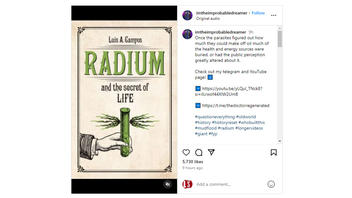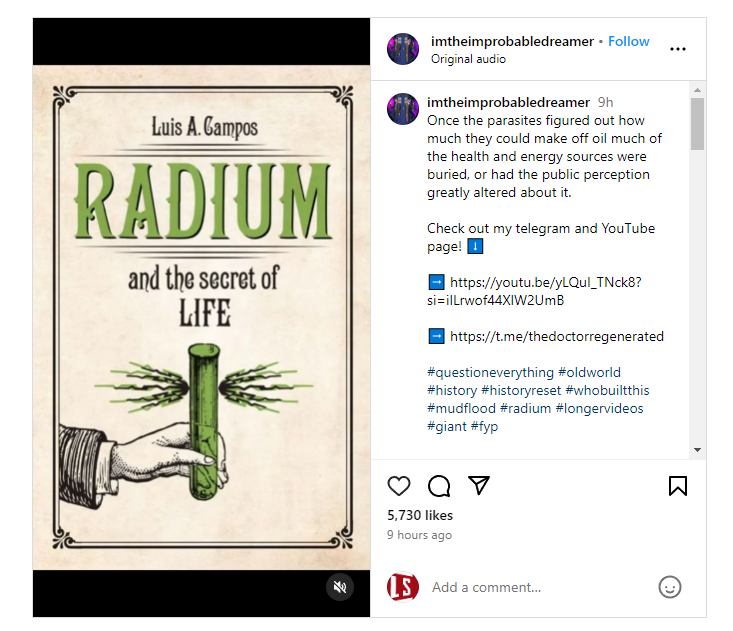
Is exposure to radium beneficial to human health, as a post on Instagram implies? No, that's not true: Radium is recognized by public health experts as a known carcinogen or cancer-causing agent. While it is true that radium was historically touted in the 20th century for its supposed health benefits and used in a variety of products at the time, evidence shows that radium is toxic and has been linked to several adverse health effects.
The claim originated in a slideshow posted on Instagram on February 26, 2024, (archived here) that claimed radium was historically "used for everything." As such, the post implied that exposure can benefit human health. A caption that accompanied the post read:
Once the parasites figured out how much they could make off oil much of the health and energy sources were buried, or had the public perception greatly altered about it.
Check out my telegram and YouTube page! ⬇️
➡️ https://youtu.be/yLQuI_TNck8?si=iILrwof44XlW2UmB
➡️ https://t.me/thedoctorregenerated
#questioneverything #oldworld #history #historyreset #whobuiltthis #mudflood #radium #longervideos #giant #fyp
Below is how the post appeared at the time of writing:
(Source: Instagram screenshot taken Tue Feb 27 07:02:00 UTC 2024)
The post implies that the historical uses of radium prove it is beneficial to health, further claiming that the "miracles of radium" show that its "potential was limitless" and its "cost minuscule."
While it is true that radium was historically touted for its now-discounted health benefits and was used in a variety of products in the early 20th century, evidence now proves radium is a toxic chemical element. Exposure has been linked (archive) to cancer and cell damage, as well as health conditions like anemia, cataracts, broken teeth and reduced bone growth.
Both the Environmental Protection Agency (EPA) (archive) and the National Academies of Sciences Committee on Biological Effects of Ionizing Radiation (archive) have stated that radium is a known human carcinogen.
Radium was once widely used in consumer, industrial products
Radium (archive) is a naturally occurring soft, silvery material that is produced by the radioactive decay of uranium, according to the U.S. Nuclear Regulatory Commission (NRC) (archive).
After its 1898 discovery (archive) by Nobel Prize-winning (archive) husband-and-wife physicists Marie and Pierre Curie, radium was used as an industrial and consumer application in food and hygiene products, and other goods in the early first half of the 20th century. These products included furniture, clothing, jewelry and, perhaps most notoriously, radium was used as a radioluminescence, or glow-in-the-dark, paint on clocks and watches and on plane dials and gauges used by pilots during World War II.
Largely following the high-profile legal battle of the so-called "Radium Girls" (archive) -- dozens of young women who died of radium paint poisoning following their work in a radium factory -- scientific experts concluded that the chemical element exposure was toxic, writes radiation expert Bert Coursey in the Journal of Research of the National Institute of Standards and Technology (archive).
Because it is so radioactive, The Royal Society of Chemistry (archive) concludes that there are few applications for its use in 2024. However, radium is sometimes used to prevent some forms of cancer from spreading to the bones.
Interestingly, a few of Marie Curie's books and papers are still so radioactive that they are stored in lead boxes, according to The Nobel Prize organization (archive). Similarly, according to the EPA (archive), radioactive antiques can continue to emit low radiation levels for thousands of years.
Radium is known to cause cancer
Radium primarily enters the body (archive) when breathed in or swallowed, though it is unknown whether it can enter through the skin. When inhaled, radium can remain in the lungs for months or eventually enter the bloodstream to be carried throughout the body. As the EPA writes (archive), radium emits alpha, beta and gamma radiation that if inhaled or swallowed is dangerous because "there is no shielding inside the body." Once in the body, radium acts similarly to calcium and can be deposited in the bones.
Though everyone is exposed to low levels of naturally occurring radium in the air, water and food, the Agency for Toxic Substances and Disease Registry (ATSDR) (archive) notes that exposure to large amounts of radium can affect the eyes as well as the hematological (blood-forming) and musculoskeletal (muscles and skeleton) systems in the body. Exposure to high levels can also result in an increased risk of bone, liver and breast cancer, wrote the agency (archive). (ATSDR posted the toxicological profile for radium here; archived here.)
Other Lead Stories fact checks related to health can be read here.
















